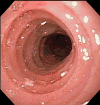The prevalence and diagnostic utility of endoscopic features of eosinophilic esophagitis: a meta-analysis
- PMID: 22610003
- PMCID: PMC3424367
- DOI: 10.1016/j.cgh.2012.04.019
The prevalence and diagnostic utility of endoscopic features of eosinophilic esophagitis: a meta-analysis
Abstract
Background & aims: Endoscopic findings such as esophageal rings, strictures, narrow-caliber esophagus, linear furrows, white plaques, and pallor or decreased vasculature might indicate the presence of eosinophilic esophagitis (EoE). We aimed to determine the prevalence and diagnostic utility of endoscopic features of EoE.
Methods: We conducted a systematic review and meta-analysis. PubMed, EMBASE, and gastrointestinal meeting abstracts were searched to identify studies that included more than 10 patients with EoE and reported endoscopic findings. Pooled prevalence, sensitivity, specificity, and predictive values were calculated using random- and mixed-effects models.
Results: The search yielded 100 articles and abstracts on 4678 patients with EoE and 2742 without (controls). In subjects with EoE, the overall pooled prevalence was as follows: esophageal rings, 44%; strictures, 21%; narrow-caliber esophagus, 9%; linear furrows, 48%; white plaques, 27%; and pallor/decreased vasculature, 41%. Substantial heterogeneity existed among studies. Results from endoscopy examinations were normal in 17% of patients, but this number decreased to 7% when the analysis was limited to prospective studies (P < .05). Overall levels of sensitivity were modest, ranging from 15% to 48%, whereas levels of specificity were greater, ranging from 90% to 95%. Positive predictive values ranged from 51% to 73% and negative predictive values ranged from 74% to 84%.
Conclusions: There is heterogeneity among studies in the reported prevalence of endoscopic findings in patients with EoE, but in prospective studies at least 1 abnormality was detected by endoscopy in 93% of patients. The operating characteristics of endoscopic findings alone are inadequate for diagnosis of EoE. Esophageal biopsy specimens should be obtained from all patients with clinical features of EoE, regardless of the endoscopic appearance of the esophagus.
Copyright © 2012 AGA Institute. Published by Elsevier Inc. All rights reserved.
Figures







Similar articles
-
Signs and symptoms to determine if a patient presenting in primary care or hospital outpatient settings has COVID-19.Cochrane Database Syst Rev. 2022 May 20;5(5):CD013665. doi: 10.1002/14651858.CD013665.pub3. Cochrane Database Syst Rev. 2022. PMID: 35593186 Free PMC article.
-
Lack of compliance with consensus recommendations on the diagnosis of eosinophilic esophagitis (EoE) in published prevalence studies. A clinical and systematic review.J Dig Dis. 2016 Oct;17(10):660-669. doi: 10.1111/1751-2980.12400. J Dig Dis. 2016. PMID: 27560909
-
Role of endoscopic esophageal dilation in managing eosinophilic esophagitis: A systematic review and meta-analysis.Medicine (Baltimore). 2017 Apr;96(14):e5877. doi: 10.1097/MD.0000000000005877. Medicine (Baltimore). 2017. PMID: 28383396 Free PMC article.
-
Surveillance of Barrett's oesophagus: exploring the uncertainty through systematic review, expert workshop and economic modelling.Health Technol Assess. 2006 Mar;10(8):1-142, iii-iv. doi: 10.3310/hta10080. Health Technol Assess. 2006. PMID: 16545207
-
Dupilumab in children with eosinophilic esophagitis: a retrospective multicenter study.BMC Pediatr. 2025 Feb 5;25(1):100. doi: 10.1186/s12887-024-05313-w. BMC Pediatr. 2025. PMID: 39910505 Free PMC article.
Cited by
-
Clinical Features of Esophageal Eosinophilia According to Endoscopic Phenotypes.Intern Med. 2020 Dec 1;59(23):2971-2979. doi: 10.2169/internalmedicine.4447-20. Epub 2020 Aug 4. Intern Med. 2020. PMID: 32759578 Free PMC article.
-
Red Between the Lines: Evolution of Eosinophilic Esophagitis as a Distinct Clinicopathologic Syndrome.Dig Dis Sci. 2020 Dec;65(12):3434-3447. doi: 10.1007/s10620-020-06642-3. Epub 2020 Oct 14. Dig Dis Sci. 2020. PMID: 33052498 Free PMC article. Review.
-
Advances in the endoscopic evaluation of eosinophilic esophagitis.Curr Opin Gastroenterol. 2016 Jul;32(4):325-31. doi: 10.1097/MOG.0000000000000278. Curr Opin Gastroenterol. 2016. PMID: 27054896 Free PMC article. Review.
-
Eosinophilic esophagitis.Gastroenterol Clin North Am. 2013 Mar;42(1):133-53. doi: 10.1016/j.gtc.2012.11.008. Epub 2012 Dec 27. Gastroenterol Clin North Am. 2013. PMID: 23452635 Free PMC article. Review.
-
Contribution of Esophagram to the Evaluation of Complicated Pediatric Eosinophilic Esophagitis.J Pediatr Gastroenterol Nutr. 2015 Nov;61(5):541-6. doi: 10.1097/MPG.0000000000000849. J Pediatr Gastroenterol Nutr. 2015. PMID: 25988559 Free PMC article.
References
-
- Landres RT, Kuster GG, Strum WB. Eosinophilic esophagitis in a patient with vigorous achalasia. Gastroenterology. 1978;74(6):1298–301. Epub 1978/06/01. - PubMed
-
- Furuta GT, Liacouras CA, Collins MH, Gupta SK, Justinich C, Putnam PE, et al. Eosinophilic esophagitis in children and adults: a systematic review and consensus recommendations for diagnosis and treatment. Gastroenterology. 2007;133(4):1342–63. Epub 2007/10/09. - PubMed
-
- Ferre-Ybarz L, Nevot Falco S, Plaza-Martin AM. Eosinophilic oesophagitis: clinical manifestations and treatment options. The role of the allergologist. Allergologia et immunopathologia. 2008;36(6):358–65. Epub 2009/01/20. - PubMed
-
- Sgouros SN, Bergele C, Mantides A. Eosinophilic esophagitis in adults: a systematic review. European journal of gastroenterology & hepatology. 2006;18(2):211–7. Epub 2006/01/06. - PubMed
Publication types
MeSH terms
Grants and funding
LinkOut - more resources
Full Text Sources
Other Literature Sources
Medical

